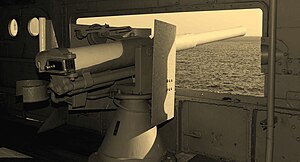QF 12 pounder 12 cwt naval gun
| Type 41 3-inch (7.62 cm) 40 calibre gun | |
|---|---|

Type 41 3-inch (7.62 cm) 40 calibre gun on the Japanese battleship Mikasa
|
|
| Type |
Naval gun Coastal artillery |
| Place of origin | United Kingdom |
| Service history | |
| In service | 1894–1945 |
| Used by |
|
| Wars |
Second Boer War British colonial conflicts Irish 1916 Easter Rising Boxer Rebellion Russo-Japanese War World War I World War II |
| Production history | |
| Designed | 1893 |
| Manufacturer |
Elswick Ordnance Company, Vickers, Japan Steel Works Canadian Pacific Railway Gio. Ansaldo & C. |
| Specifications | |
| Weight | 0.6 tons (510 kg) |
| Length | 10 ft 3 in (3.12 m) |
| Barrel length | 10 ft (3 m) |
|
|
|
| Shell | UK & Japan : Separate-loading QF Italy : Fixed QF |
| Calibre | 3-inch (7.62 cm) |
| Breech | single-motion screw |
| Elevation | mounting dependent |
| Traverse | mounting dependent |
| Rate of fire | 15 rounds per minute |
| Muzzle velocity | 2,210 ft/s (670 m/s) |
| Effective firing range | 11,750 yd (10,740 m) at 40° elevation |
| Feed system | Breech-loaded |
The QF 12 pounder 12 cwt gun was a common, versatile 3-inch (76 mm) calibre naval gun introduced in 1894 and used until the middle of the 20th century. It was produced by Armstrong Whitworth, Elswick and used on Royal Navy warships, and exported to allied countries. In British service, "12 pounder" was a rounded reference to the projectile weight and "12 cwt" referred to the weight of the barrel and breech : 12 hundredweight = 12 x 112 pounds = 1344 pounds, to differentiate it from other "12 pounder" guns.
As the Type 41 3-inch (76.2 mm)/40 it was used on most early battleships and cruisers of the Imperial Japanese Navy, though it was commonly referred to by its UK designation as a “12-pounder” gun.
Mk I and II guns, of "built up" construction of multiple steel layers, served on many Royal Navy destroyers up to and after World War I originally as primary and later as secondary armament against submarines and torpedo boats. They were also fitted as deck guns on D and E-class submarines.
In World War II many Mk V guns, which had a "monobloc" barrel made of a single casting, served on smaller escort ships such as destroyers and on armed merchant ships, on dual-purpose high-low angle mountings which also allowed it to be used as an anti-aircraft gun.
The gun was primarily a high-velocity naval gun, with its heavy recoil suiting it to static mountings, hence it was generally considered unsuitable for use as a mobile field gun. An exception was made when the British Army were outgunned by the Boer artillery in South Africa and the Royal Navy was called on for help. Among other guns, 16 QF 12 pounder 12 cwt were landed from warships and were mounted on improvised field carriages designed by Captain Percy Scott RN, with solid wooden trails and utilizing small-diameter Cape wagon wheels. Their 10,000-yard (9,100 m) range provided valuable long-range fire support for the army throughout the war. They were known as "long twelves" to distinguish them from the BL 12-pounder 6 cwt and QF 12-pounder 8 cwt which had much shorter barrels and ranges.
...
Wikipedia
